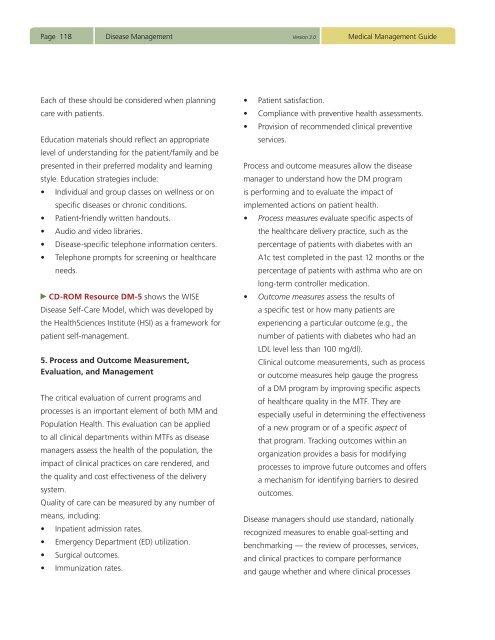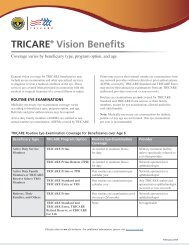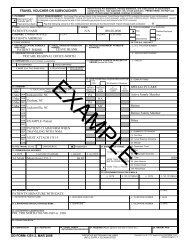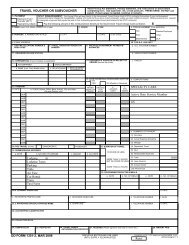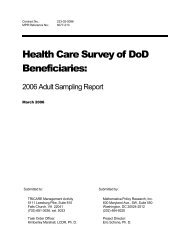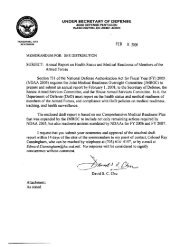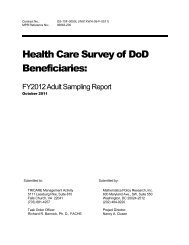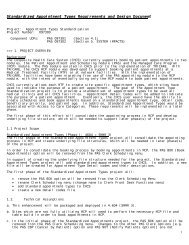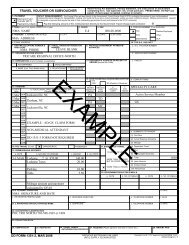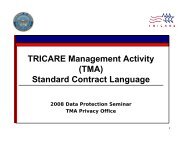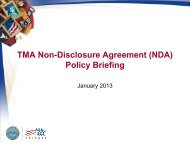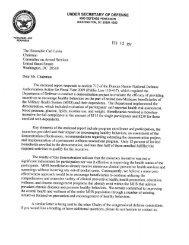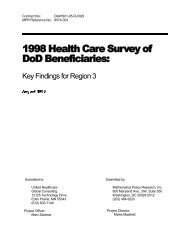Medical Management Guide, 2009, Version 3.0 - Tricare
Medical Management Guide, 2009, Version 3.0 - Tricare
Medical Management Guide, 2009, Version 3.0 - Tricare
- No tags were found...
Create successful ePaper yourself
Turn your PDF publications into a flip-book with our unique Google optimized e-Paper software.
Page 118Disease <strong>Management</strong> <strong>Version</strong> <strong>3.0</strong><strong>Medical</strong> <strong>Management</strong> <strong>Guide</strong>Each of these should be considered when planningcare with patients.Education materials should reflect an appropriatelevel of understanding for the patient/family and bepresented in their preferred modality and learningstyle. Education strategies include:• Individual and group classes on wellness or onspecific diseases or chronic conditions.• Patient-friendly written handouts.• Audio and video libraries.• Disease-specific telephone information centers.• Telephone prompts for screening or healthcareneeds.CD-ROM Resource DM-5 shows the WISEDisease Self-Care Model, which was developed bythe HealthSciences Institute (HSI) as a framework forpatient self-management.5. Process and Outcome Measurement,Evaluation, and <strong>Management</strong>The critical evaluation of current programs andprocesses is an important element of both MM andPopulation Health. This evaluation can be appliedto all clinical departments within MTFs as diseasemanagers assess the health of the population, theimpact of clinical practices on care rendered, andthe quality and cost effectiveness of the deliverysystem.Quality of care can be measured by any number ofmeans, including:• Inpatient admission rates.• Emergency Department (ED) utilization.• Surgical outcomes.• Immunization rates.• Patient satisfaction.• Compliance with preventive health assessments.• Provision of recommended clinical preventiveservices.Process and outcome measures allow the diseasemanager to understand how the DM programis performing and to evaluate the impact ofimplemented actions on patient health.• Process measures evaluate specific aspects ofthe healthcare delivery practice, such as thepercentage of patients with diabetes with anA1c test completed in the past 12 months or thepercentage of patients with asthma who are onlong-term controller medication.• Outcome measures assess the results ofa specific test or how many patients areexperiencing a particular outcome (e.g., thenumber of patients with diabetes who had anLDL level less than 100 mg/dl).Clinical outcome measurements, such as processor outcome measures help gauge the progressof a DM program by improving specific aspectsof healthcare quality in the MTF. They areespecially useful in determining the effectivenessof a new program or of a specific aspect ofthat program. Tracking outcomes within anorganization provides a basis for modifyingprocesses to improve future outcomes and offersa mechanism for identifying barriers to desiredoutcomes.Disease managers should use standard, nationallyrecognized measures to enable goal-setting andbenchmarking — the review of processes, services,and clinical practices to compare performanceand gauge whether and where clinical processes


